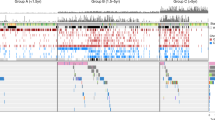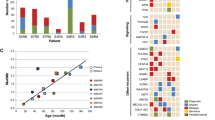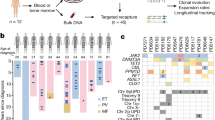Abstract
Neuroblastoma is a childhood cancer that can be inherited, but the genetic aetiology is largely unknown. Here we show that germline mutations in the anaplastic lymphoma kinase (ALK) gene explain most hereditary neuroblastomas, and that activating mutations can also be somatically acquired. We first identified a significant linkage signal at chromosome bands 2p23–24 using a whole-genome scan in neuroblastoma pedigrees. Resequencing of regional candidate genes identified three separate germline missense mutations in the tyrosine kinase domain of ALK that segregated with the disease in eight separate families. Resequencing in 194 high-risk neuroblastoma samples showed somatically acquired mutations in the tyrosine kinase domain in 12.4% of samples. Nine of the ten mutations map to critical regions of the kinase domain and were predicted, with high probability, to be oncogenic drivers. Mutations resulted in constitutive phosphorylation, and targeted knockdown of ALK messenger RNA resulted in profound inhibition of growth in all cell lines harbouring mutant or amplified ALK, as well as in two out of six wild-type cell lines for ALK. Our results demonstrate that heritable mutations of ALK are the main cause of familial neuroblastoma, and that germline or acquired activation of this cell-surface kinase is a tractable therapeutic target for this lethal paediatric malignancy.
This is a preview of subscription content, access via your institution
Access options
Subscribe to this journal
Receive 51 print issues and online access
$199.00 per year
only $3.90 per issue
Buy this article
- Purchase on Springer Link
- Instant access to full article PDF
Prices may be subject to local taxes which are calculated during checkout





Similar content being viewed by others
Change history
16 October 2008
The AOP version of this paper contained an affiliation error and an erroneous sentence in the Discussion. These were corrected for print on 16 October 2008.
References
Maris, J. M., Hogarty, M. D., Bagatell, R. & Cohn, S. L. Neuroblastoma. Lancet 369, 2106–2120 (2007)
Matthay, K. K. et al. Treatment of high-risk neuroblastoma with intensive chemotherapy, radiotherapy, autologous bone marrow transplantation, and 13-cis-retinoic acid. Children’s Cancer Group. N. Engl. J. Med. 341, 1165–1173 (1999)
Schwab, M. et al. Chromosome localization in normal human cells and neuroblastomas of a gene related to c-myc . Nature 308, 288–291 (1984)
Attiyeh, E. F. et al. Chromosome 1p and 11q deletions and outcome in neuroblastoma. N. Engl. J. Med. 353, 2243–2253 (2005)
Knudson, A. G. J. & Strong, L. C. Mutation and cancer: Neuroblastoma and pheochromocytoma. Am. J. Hum. Genet. 24, 514–522 (1972)
Kushner, B. H., Gilbert, F. & Helson, L. Familial neuroblastoma. Case reports, literature review, and etiologic considerations. Cancer 57, 1887–1893 (1986)
Maris, J. M. et al. Molecular genetic analysis of familial neuroblastoma. Eur. J. Cancer 33, 1923–1928 (1997)
Friedman, D. L. et al. Increased risk of cancer among siblings of long-term childhood cancer survivors: a report from the childhood cancer survivor study. Cancer Epidemiol. Biomarkers Prev. 14, 1922–1927 (2005)
Maris, J. M. & Brodeur, G. M. in Neuroblastoma (eds Cheung, N.-K. V. & Cohn, S. L.) 21–26 (Springer, 2005)
Longo, L. et al. Genetic predisposition to familial neuroblastoma: identification of two novel genomic regions at 2p and 12p. Hum. Hered. 63, 205–211 (2007)
Maris, J. M. et al. Evidence for a hereditary neuroblastoma predisposition locus at chromosome 16p12–13. Cancer Res. 62, 6651–6658 (2002)
Perri, P. et al. Weak linkage at 4p16 to predisposition for human neuroblastoma. Oncogene 21, 8356–8360 (2002)
Amiel, J. et al. Polyalanine expansion and frameshift mutations of the paired-like homeobox gene PHOX2B in congenital central hypoventilation syndrome. Nature Genet. 33, 459–461 (2003)
Mosse, Y. P. et al. Germline PHOX2B mutation in hereditary neuroblastoma. Am. J. Hum. Genet. 75, 727–730 (2004)
Trochet, D. et al. Germline mutations of the paired-like homeobox 2B (PHOX2B) gene in neuroblastoma. Am. J. Hum. Genet. 74, 761–764 (2004)
Raabe, E. H. et al. Prevalence and functional consequence of PHOX2B mutations in neuroblastoma. Oncogene 27, 469–476 (2008)
van Limpt, V. et al. The Phox2B homeobox gene is mutated in sporadic neuroblastomas. Oncogene 23, 9280–9288 (2004)
Weiss, W. A., Aldape, K., Mohapatra, G., Feuerstein, B. G. & Bishop, J. M. Targeted expression of MYCN causes neuroblastoma in transgenic mice. EMBO J. 16, 2985–2995 (1997)
Osajima-Hakomori, Y. et al. Biological role of anaplastic lymphoma kinase in neuroblastoma. Am. J. Pathol. 167, 213–222 (2005)
George, R. E. et al. Genome-wide analysis of neuroblastomas using high-density single nucleotide polymorphism arrays. PLoS ONE 2, e255 (2007)
Morris, S. W. et al. Fusion of a kinase gene, ALK, to a nucleolar protein gene, NPM, in non-Hodgkin’s lymphoma. Science 263, 1281–1284 (1994)
Griffin, C. A. et al. Recurrent involvement of 2p23 in inflammatory myofibroblastic tumors. Cancer Res. 59, 2776–2780 (1999)
Jazii, F. R. et al. Identification of squamous cell carcinoma associated proteins by proteomics and loss of beta tropomyosin expression in esophageal cancer. World J. Gastroenterol. 12, 7104–7112 (2006)
Soda, M. et al. Identification of the transforming EML4–ALK fusion gene in non-small-cell lung cancer. Nature 448, 561–566 (2007)
Rikova, K. et al. Global survey of phosphotyrosine signaling identifies oncogenic kinases in lung cancer. Cell 131, 1190–1203 (2007)
Torkamani, A. & Schork, N. J. Accurate prediction of deleterious protein kinase polymorphisms. Bioinformatics 23, 2918–2925 (2007)
Torkamani, A. & Schork, N. J. Prediction of cancer driver mutations in protein kinases. Cancer Res. 68, 1675–1682 (2008)
Ikenoue, T. et al. Functional analysis of mutations within the kinase activation segment of B-Raf in human colorectal tumors. Cancer Res. 63, 8132–8137 (2003)
Ikenoue, T. et al. Different effects of point mutations within the B-Raf glycine-rich loop in colorectal tumors on mitogen-activated protein/extracellular signal-regulated kinase kinase/extracellular signal-regulated kinase and nuclear factor κB pathway and cellular transformation. Cancer Res. 64, 3428–3435 (2004)
Kannan, N. & Neuwald, A. F. Did protein kinase regulatory mechanisms evolve through elaboration of a simple structural component? J. Mol. Biol. 351, 956–972 (2005)
Jeffers, M. et al. Activating mutations for the met tyrosine kinase receptor in human cancer. Proc. Natl Acad. Sci. USA 94, 11445–11450 (1997)
Balak, M. N. et al. Novel D761Y and common secondary T790M mutations in epidermal growth factor receptor-mutant lung adenocarcinomas with acquired resistance to kinase inhibitors. Clin. Cancer Res. 12, 6494–6501 (2006)
Lee, J. W. et al. ERBB2 kinase domain mutation in the lung squamous cell carcinoma. Cancer Lett. 237, 89–94 (2006)
Lee, J. W. et al. Somatic mutations of ERBB2 kinase domain in gastric, colorectal, and breast carcinomas. Clin. Cancer Res. 12, 57–61 (2006)
Wang, Q. et al. Integrative genomics identifies distinct molecular classes of neuroblastoma and shows that multiple genes are targeted by regional alterations in DNA copy number. Cancer Res. 66, 6050–6062 (2006)
Vogelstein, B. & Kinzler, K. W. Cancer genes and the pathways they control. Nature Med. 10, 789–799 (2004)
Maris, J. M. et al. Chromosome 6p22 locus associated with clinically aggressive neuroblastoma. N. Engl. J. Med. 358, 2585–2593 (2008)
Iwahara, T. et al. Molecular characterization of ALK, a receptor tyrosine kinase expressed specifically in the nervous system. Oncogene 14, 439–449 (1997)
Chiarle, R., Voena, C., Ambrogio, C., Piva, R. & Inghirami, G. The anaplastic lymphoma kinase in the pathogenesis of cancer. Nature Rev. Cancer 8, 11–23 (2008)
Lamant, L. et al. Expression of the ALK tyrosine kinase gene in neuroblastoma. Am. J. Pathol. 156, 1711–1721 (2000)
Motegi, A., Fujimoto, J., Kotani, M., Sakuraba, H. & Yamamoto, T. ALK receptor tyrosine kinase promotes cell growth and neurite outgrowth. J. Cell Sci. 117, 3319–3329 (2004)
Miyake, I. et al. Activation of anaplastic lymphoma kinase is responsible for hyperphosphorylation of ShcC in neuroblastoma cell lines. Oncogene 21, 5823–5834 (2002)
Dirks, W. G. et al. Expression and functional analysis of the anaplastic lymphoma kinase (ALK) gene in tumor cell lines. Int. J. Cancer 100, 49–56 (2002)
McDermott, U. et al. Genomic alterations of anaplastic lymphoma kinase may sensitize tumors to anaplastic lymphoma kinase inhibitors. Cancer Res. 68, 3389–3395 (2008)
Wigginton, J. E. & Abecasis, G. R. PEDSTATS: descriptive statistics, graphics and quality assessment for gene mapping data. Bioinformatics 21, 3445–3447 (2005)
Abecasis, G. R., Cherny, S. S., Cookson, W. O. & Cardon, L. R. Merlin–rapid analysis of dense genetic maps using sparse gene flow trees. Nature Genet. 30, 97–101 (2002)
Li, M., Boehnke, M. & Abecasis, G. R. Joint modeling of linkage and association: identifying SNPs responsible for a linkage signal. Am. J. Hum. Genet. 76, 934–949 (2005)
Yu, N. et al. Real-time monitoring of morphological changes in living cells by electronic cell sensor arrays: an approach to study G protein-coupled receptors. Anal. Chem. 78, 35–43 (2006)
Cole, K. A. et al. A functional screen identifies miR-34a as a candidate neuroblastoma tumor suppressor gene. Mol. Cancer Res. 6, 735–742 (2008)
Livak, K. J. & Schmittgen, T. D. Analysis of relative gene expression data using real-time quantitative PCR and the 2-ΔΔC T method. Methods 25, 402–408 (2001)
Acknowledgements
We acknowledge the families and children that participated in this research study, and the Children’s Oncology Group for providing specimens. We thank W. London for providing statistical analyses related to the Children’s Oncology Group tumour set, H. Rydbeck for his assistance with the linkage analysis, M. Wasik for technical assistance, and J. Felgenhauer, N. Van Roy and C. McConville for providing neuroblastoma pedigrees. This work was supported in part by National Institutes of Health grants K08-111733 (Y.P.M.), R01-CA78454 (J.M.M.), R01-CA87847 (J.M.M.), an American Society of Clinical Oncology Career Development Award (Y.P.M.), the Foerderer-Murray Fund (Y.P.M.), the Carly Hillman Fund (Y.P.M.), the Alex’s Lemonade Stand Foundation (J.M.M.), the Andrew’s Army Foundation (J.M.M.), the Giulio D’Angio Endowed Chair (J.M.M.), the Italian Neuroblastoma Foundation (L.L.), the Center for Applied Genomics at the Joseph Stokes Research Institute (H.H.), Scripps Genomic Medicine (A.T., N.J.S.), the Scripps Dickinson Scholarship (A.T.), and the Abramson Family Cancer Research Institute (J.M.M.).
Author Contributions Y.P.M. and J.M.M. designed the experiments and wrote the manuscript. Y.P.M., M.L., J.M.M., G.L., F.S., P.P. and G.P.T. collected the families for the linkage analysis. Y.P.M., M.L., L.L., C.K., C.H., E.R., H.H. and M.D. performed the genome-wide genotyping and linkage analysis. M.L. performed the DNA sequencing and analyses. K.A.C., A.W. and M.J.L. performed the siRNA experiments. E.F.A., H.H. and Y.P.M. performed the tumour SNP genotyping/copy number analyses. J.E.L., K.A.C. and A.W. performed the expression analyses. K.A.C., R.S. and M.L. performed the protein work. G.M.B. initiated the collection of neuroblastoma pedigrees. A.T. and N.J.S. performed the structural analysis of ALK coding mutations.
Author information
Authors and Affiliations
Corresponding author
Rights and permissions
About this article
Cite this article
Mossé, Y., Laudenslager, M., Longo, L. et al. Identification of ALK as a major familial neuroblastoma predisposition gene. Nature 455, 930–935 (2008). https://doi.org/10.1038/nature07261
Received:
Accepted:
Published:
Issue Date:
DOI: https://doi.org/10.1038/nature07261
This article is cited by
-
Bilateral adrenal neuroblastoma: peculiar pattern of a rare pediatric presentation
Discover Oncology (2024)
-
Comprehensive exploration of the involvement of cuproptosis in tumorigenesis and progression of neuroblastoma
BMC Genomics (2023)
-
Metastasis pattern and prognosis in children with neuroblastoma
World Journal of Surgical Oncology (2023)
-
RTEL1 gene polymorphisms and neuroblastoma risk in Chinese children
BMC Cancer (2023)
-
ALK fusions in the pan-cancer setting: another tumor-agnostic target?
npj Precision Oncology (2023)
Comments
By submitting a comment you agree to abide by our Terms and Community Guidelines. If you find something abusive or that does not comply with our terms or guidelines please flag it as inappropriate.



